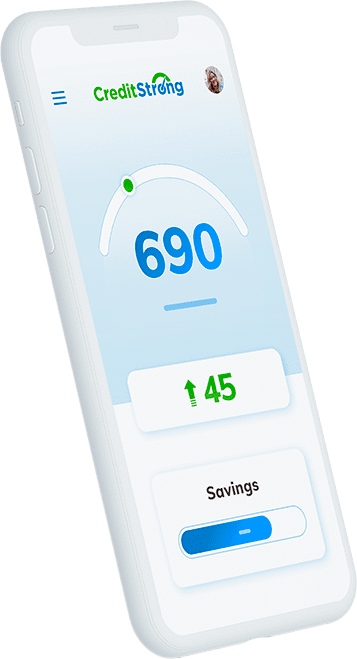The Amount You Owe

Build strong credit
while you save
Amounts Owed reflects how much you owe each creditor individually and in total. It includes your utilization rate for revolving lines of credit (e.g. credit cards). Approximately 30% of a FICO® Score is based on information which evaluates indebtedness. In this category, FICO® Scores take into account:
- The amount owed on all accounts.
- The amount owed on different types of accounts.
- The balances owed on certain types of accounts.
- The number of accounts which carry a balance.
- How much of the total credit line is being used on credit cards and other revolving credit accounts.
- How much is still owed on installment loan accounts, compared with the original loan amounts.
Credit utilization, one of the most important factors evaluated in this category, considers the amount you owe compared to how much credit you have available. For example, if you have a $2,000 balance on one card and a $3,000 balance on another, and each card has a $5,000 limit, your credit utilization rate would be 50%. While lenders determine how much credit they are willing to provide, you control how much you use. FICO’s research shows that people using a high percentage of their available credit limits are more likely to have trouble making some payments now or in the near future, compared to people using a lower level of credit.
Having credit accounts with an outstanding balance does not necessarily mean you are a high-risk borrower with a low FICO® Score. A long history of demonstrating consistent payments on credit accounts is a good way to show lenders you can responsibly manage additional credit.
The Amount Owed on All Accounts
In general, showing less debt on your credit report makes you a more attractive prospect to lenders. The first thing they consider when examining your amounts owed is your total outstanding debt balance.
Note that FICO says this data point isn’t as significant as other aspects of your amounts owed in calculating your credit score, most likely because it doesn’t tell you much about a borrower’s creditworthiness on its own.
For example, say that John and Mary each have $100,000 of debt. John’s is all credit card debt with a 15% interest rate, but Mary’s is the remaining third of a $300,000 mortgage liability.
All else being equal, lenders would prefer to lend to Mary, despite her and John owing the same amounts.
The Amount Owed on Different Types of Accounts
In addition to considering your total outstanding debt balances, lenders will also monitor how much you owe on groups of credit accounts, like credit cards or installment loans.
Not all types of debt are equally burdensome to the borrower so it gives lenders a more accurate understanding of your debt situation. Plus, they might not want to give you too much of one kind of debt.
For example, say apply for a car loan, but you already have a $5,000 debt. Your lender might approve you if that debt is a credit card with a $30 minimum monthly payment.
However, that becomes much less likely if the $5,000 was another car loan with a three-year repayment term and $350 installments instead.
The Number of Accounts That Carry a Balance
The more credit accounts you have with an outstanding balance, the riskier you look to a creditor. Again, the data point doesn’t prove anything in isolation, but it suggests something about your habits as a borrower.
In general, people tend to rack up charges on new accounts when they run out of available credit on their other ones. Doing that will make lenders suspect you’re overextended.
For example, say you have five credit cards, each with a credit limit of $2,000. If you only have an existing balance on one of them, it’s clear that you don’t depend too much on your credit.
However, if you maxed out your balances on all five, lenders might think you rely on borrowing too much, making you more likely to miss a payment.
How Much of the Total Credit Line Is Being Used on Credit Cards and Other Revolving Credit Accounts?
The previous considerations have all been isolated data points, and they tend to only provide marginal insight into a borrower’s credit habits.
Your credit utilization, which is the amount you owe on revolving credit accounts divided by their credit limits, is much more meaningful.
For example, if you owe $250 on a credit card with a $2,500 limit, your credit utilization ratio is 10%. That alone tells you a lot about the borrower’s discipline with credit. Just knowing they have a $250 balance does not.
You’ll often hear you should keep your credit utilization below 30%, but lower is always better. To get the best results, try to keep it between 1% and 10%.
Reporting 0% is better than a much higher ratio, but it probably won’t benefit you as much as a single-digit ratio because lenders might think you’re not using the account.
How Much Is Still Owed on Installment Loan Accounts, Compared With the Original Loan Amounts?
Lastly, lenders will consider the amounts you owe on your installment accounts in light of their original balances. The lower the percentage, the more your credit score will benefit. Think of this as the equivalent of credit utilization for installment debt.
For example, say you take $200,000 in federal student loans. After one year, you owe $190,000, which is 95% of the original principal balance.
If you received a windfall and paid down the student loan debt by $100,000, you’d owe $90,000, which would be only 45% of the original balance. Reducing the percentage that much would significantly boost your credit score.
CreditStrong helps improve your credit and can positively impact the factors that determine 90% of your FICO score.
